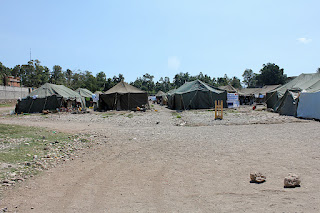We also presented an entertaining and uplifting show for the camp communities. It's called The Flying Head! Based on an Native American folk tale, it's a show about a village that is terrorized by a horrible monster and one woman who stands up and rallies the community together to defeat it. The "monster" is made out of blue tarp and plastic bags and looks quite silly. The whole show is silly, but with an underlying message of hope and resilience in the face of diversity as long as you take personal responsibility to find a solution and come together as a community.
My favorite performance, I have to say, was at a little school in Jacmel, where the students jumped up and down screaming with excitement at our antics! It was amazing! This happened whenever we did any of our acrobatic tricks and they went wild when Morlon launched into his sprightly slapstick silliness. It was such a surprise visit (arranged very suddenly and last minute), and I have a feeling they had never seen anything like it before in their lives!
We performed and did workshops with the kids in about five different camps in the Port-au-Prince area: Camp Matissant, Camp Bobin and Bristout, Camp Jean-Marie Vincent; and also Camp Pinchinat in Jacmel.
 One of the first camps we visited was Camp Pinchinat. Although in most camps I have seen people live in fairly small tents or just tarps hung over some sticks, in this camp there were large green military tents but each tent apparently houses up to five families! Crammed together in this space, there is no privacy whatsoever. There have been a lot of problems and a lot of tension in the camp.
One of the first camps we visited was Camp Pinchinat. Although in most camps I have seen people live in fairly small tents or just tarps hung over some sticks, in this camp there were large green military tents but each tent apparently houses up to five families! Crammed together in this space, there is no privacy whatsoever. There have been a lot of problems and a lot of tension in the camp.
We walk through the camp, and a woman sitting outside of her tent spots us and shouts out from twenty feet away, "I am hungry, give me money!" A strong sense of dependency and entitlement has set in. You are a foreigner, you are rich, give me. A foreigner in the camp is associated with material aid. Certainly no one expects a foreigner to come into the camp just to play!
As we walk down the path, I see a little girl come running towards us with outstretched arms, full of excitement. She runs straight up to me and throws her arms around me! Then she continues on with us, holding my hand. So many of the children climb up in our arms, clinging to us and not wanting to let go. There is such an apparent need for love and attention.
More notes on our camp experiences to follow....
My favorite performance, I have to say, was at a little school in Jacmel, where the students jumped up and down screaming with excitement at our antics! It was amazing! This happened whenever we did any of our acrobatic tricks and they went wild when Morlon launched into his sprightly slapstick silliness. It was such a surprise visit (arranged very suddenly and last minute), and I have a feeling they had never seen anything like it before in their lives!
We performed and did workshops with the kids in about five different camps in the Port-au-Prince area: Camp Matissant, Camp Bobin and Bristout, Camp Jean-Marie Vincent; and also Camp Pinchinat in Jacmel.
 One of the first camps we visited was Camp Pinchinat. Although in most camps I have seen people live in fairly small tents or just tarps hung over some sticks, in this camp there were large green military tents but each tent apparently houses up to five families! Crammed together in this space, there is no privacy whatsoever. There have been a lot of problems and a lot of tension in the camp.
One of the first camps we visited was Camp Pinchinat. Although in most camps I have seen people live in fairly small tents or just tarps hung over some sticks, in this camp there were large green military tents but each tent apparently houses up to five families! Crammed together in this space, there is no privacy whatsoever. There have been a lot of problems and a lot of tension in the camp.We walk through the camp, and a woman sitting outside of her tent spots us and shouts out from twenty feet away, "I am hungry, give me money!" A strong sense of dependency and entitlement has set in. You are a foreigner, you are rich, give me. A foreigner in the camp is associated with material aid. Certainly no one expects a foreigner to come into the camp just to play!
As we walk down the path, I see a little girl come running towards us with outstretched arms, full of excitement. She runs straight up to me and throws her arms around me! Then she continues on with us, holding my hand. So many of the children climb up in our arms, clinging to us and not wanting to let go. There is such an apparent need for love and attention.
More notes on our camp experiences to follow....































































